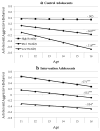Developmental differences in early adolescent aggression: a gene × environment × intervention analysis
- PMID: 25319639
- PMCID: PMC4324089
- DOI: 10.1007/s10964-014-0198-4
Developmental differences in early adolescent aggression: a gene × environment × intervention analysis
Abstract
Aggression-related problems such as assault and homicide among adolescents and young adults exact considerable social and economic costs. Although progress has been made, additional research is needed to help combat this persistent problem. Several lines of research indicate that parental hostility is an especially potent predictor of adolescent aggression, although most longitudinal research has focused on clarifying the direction of effects. In this study, we used longitudinal data from the PROSPER project (N = 580; 54.8% female), a primarily rural Caucasian preventative intervention sample, to examine developmental change in early- to mid-adolescent aggressive behavior problems (age 11-16 years). In addition, we examined maternal hostility as a predictor of developmental change in aggression and the PROSPER preventative intervention, designed to reduce substance use and aggression, as a potential influence on this association. Lastly, several studies indicate that variation in the DRD4 7-repeat gene moderates both parenting and intervention influences on externalizing behavior. Accordingly, we examined the potential moderating role of DRD4. As hypothesized, there was a significant maternal hostility by intervention interaction indicating that the intervention reduced the negative impact of maternal hostility on adolescent change in aggressive behavior problems. DRD4 7-repeat status (7+ vs. 7-) further conditioned this association whereby control group 7+ adolescents with hostile mothers showed increasing aggressive behavior problems. In contrast, aggression decreased for 7+ adolescents with similarly hostile mothers in the intervention. Implications for prevention are discussed as well as current perspectives in candidate gene-by-environment interaction research.
Figures


Similar articles
-
Mothering versus fathering? Positive parenting versus negative parenting? Their relative importance in predicting adolescent aggressive behavior: A longitudinal comparison.Dev Psychol. 2023 Jan;59(1):69-83. doi: 10.1037/dev0001442. Epub 2022 Sep 8. Dev Psychol. 2023. PMID: 36074588 Free PMC article.
-
Are infants differentially sensitive to parenting? Early maternal care, DRD4 genotype and externalizing behavior during adolescence.J Psychiatr Res. 2014 Dec;59:53-9. doi: 10.1016/j.jpsychires.2014.08.012. Epub 2014 Aug 27. J Psychiatr Res. 2014. PMID: 25194232
-
The dopamine receptor D4 gene and familial loading interact with perceived parenting in predicting externalizing behavior problems in early adolescence: the TRacking Adolescents' Individual Lives Survey (TRAILS).Psychiatry Res. 2013 Aug 30;209(1):66-73. doi: 10.1016/j.psychres.2012.10.022. Epub 2012 Dec 14. Psychiatry Res. 2013. PMID: 23246383
-
The aggressive child.J Paediatr Child Health. 2018 Oct;54(10):1165-1169. doi: 10.1111/jpc.14182. J Paediatr Child Health. 2018. PMID: 30294979 Review.
-
Genetics of child aggression, a systematic review.Transl Psychiatry. 2024 Jun 11;14(1):252. doi: 10.1038/s41398-024-02870-7. Transl Psychiatry. 2024. PMID: 38862490 Free PMC article.
Cited by
-
Physiological Genomics Plays a Crucial Role in Response to Stressful Life Events, the Development of Aggressive Behaviours, and Post-Traumatic Stress Disorder (PTSD).Genes (Basel). 2022 Feb 4;13(2):300. doi: 10.3390/genes13020300. Genes (Basel). 2022. PMID: 35205345 Free PMC article. Review.
-
Mothering versus fathering? Positive parenting versus negative parenting? Their relative importance in predicting adolescent aggressive behavior: A longitudinal comparison.Dev Psychol. 2023 Jan;59(1):69-83. doi: 10.1037/dev0001442. Epub 2022 Sep 8. Dev Psychol. 2023. PMID: 36074588 Free PMC article.
-
Direct and Indirect Longitudinal Associations of Mother and Father Engagement in Middle Childhood on Adolescent Externalizing and Internalizing Behaviors.J Youth Adolesc. 2024 Aug;53(8):1832-1846. doi: 10.1007/s10964-024-01982-z. Epub 2024 Apr 10. J Youth Adolesc. 2024. PMID: 38600264 Free PMC article.
-
Developing a Short-Form Buss-Warren Aggression Questionnaire Based on Machine Learning.Behav Sci (Basel). 2023 Sep 26;13(10):799. doi: 10.3390/bs13100799. Behav Sci (Basel). 2023. PMID: 37887449 Free PMC article.
-
Underlying Mechanisms of Gene-Environment Interactions in Externalizing Behavior: A Systematic Review and Search for Theoretical Mechanisms.Clin Child Fam Psychol Rev. 2015 Dec;18(4):413-42. doi: 10.1007/s10567-015-0196-4. Clin Child Fam Psychol Rev. 2015. PMID: 26537239 Free PMC article.
References
-
- Achenbach TM. Integrative guide for the 1991 CBCL/4-18, YSR, and TRF profiles. 1991 Retrieved from http://www.getcited.org/pub/102906443.
-
- Anchordoquy HC, McGeary C, Liu L, Krauter KS, Smolen A. Genotyping of three candidate genes after whole-genome preamplification of DNA collected from buccal cells. Behavior Genetics. 2003;33:73–78. - PubMed
-
- Asghari V, Sanyal S, Buchwaldt S, Paterson A, Jovanovic V, Van Tol HH. Modulation of intracellular cyclic AMP levels by different human dopamine D4 receptor variants. Journal of Neurochemistry. 1995;65:1157–1165. - PubMed
Publication types
MeSH terms
Substances
Grants and funding
LinkOut - more resources
Full Text Sources
Other Literature Sources
Medical
Research Materials

